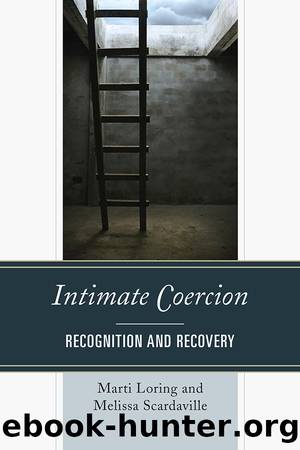Intimate Coercion by Marti Loring & Melissa Scardaville

Author:Marti Loring & Melissa Scardaville [Loring, Marti & Scardaville, Melissa]
Language: eng
Format: epub
Publisher: Rowman & Littlefield Publishers
Published: 2015-12-15T00:00:00+00:00
All of these areas are important to discuss with the woman. She can provide contact information for collateral witnessesâothers with knowledge about her life/relationships.
When Coercion Is Important
If an attorney suspects abuse and coercion when a woman has been accused of illegal behavior along with her partner, an expert may be called upon to evaluate the individual. These crimes can include fraud, robbery, theft, driving violations, kidnapping, drugs, child abuse, assault, murder, and bombings, among others. At first, both the woman and her partner may be accused without any separation of responsibility (who played what part in the crime). But if a woman has experienced coercion, her role in the illegal incident can be understood in a different light. Coercion may be a mitigating factor when sentencing is considered in both state and federal courts.
Sometimes the expert testifies in front of a jury. Other times there is no jury and a judge makes the determination of punishment, as in Mariaâs case, which follows. In this case, the defense lawyer and the district attorney both acknowledged that Maria was guilty, but they could not agree about her sentence. So they asked the judge to decide, bringing to him a plea of guilty and presenting both sides. The district attorney wanted Maria to have a jail sentence, while the defense lawyer asked for probation with no jail time.
Maria
Maria, a thirty-two-year-old administrative assistant in an automotive store, was accused of theft when merchandise began disappearing during hours that she worked late, after all of the other employees had left the store. When questioned by the manager, Maria appeared nervous and cried, rather than denying any involvement. Police were called, and she demonstrated the same anxious behavior. After Maria was arrested, her home was searched and some of the stolen items were found.
Her boyfriend, Lewis, disappeared, and only later were the police able to locate and arrest him. A detective discovered that he had been selling items stolen from the store. Their seven-year-old daughter, Mia, was taken into foster care. Both the police and Mariaâs attorney suspected coercion. When Maria and her boyfriend were both in the courtroom together for a hearing, Maria hid first behind a police officer and then, grabbing her lawyerâs jacket, hid behind him, trying to avoid Lewisâs angry glares and fist-shaking gestures. Many in the courtroom saw him shake his fist at her until a court deputy told him to stop. Maria began shaking and crying. Later, during a psychosocial evaluation, she described her fear. âWhen he shook his fist, I almost fainted. I just knew heâd hurt our daughter Mia. That was what heâd do before hurting herâshake his fist.â
Areas for Exploration
There are many areas for exploration when evaluating a person who may or may not have been coerced during her participation in a crime.
What kinds of experiences could have led to her present situation?
Have there been abusive experiences during her life that would add understanding to the incident for which she is now in trouble?
If she is
Download
This site does not store any files on its server. We only index and link to content provided by other sites. Please contact the content providers to delete copyright contents if any and email us, we'll remove relevant links or contents immediately.
| Administration & Medicine Economics | Allied Health Professions |
| Basic Sciences | Dentistry |
| History | Medical Informatics |
| Medicine | Nursing |
| Pharmacology | Psychology |
| Research | Veterinary Medicine |
Machine Learning at Scale with H2O by Gregory Keys | David Whiting(3647)
Fairy Tale by Stephen King(2956)
Will by Will Smith(2582)
Hooked: A Dark, Contemporary Romance (Never After Series) by Emily McIntire(2424)
Rationality by Steven Pinker(2151)
Friends, Lovers, and the Big Terrible Thing by Matthew Perry(2005)
The Becoming by Nora Roberts(1922)
Love on the Brain by Ali Hazelwood(1820)
HBR's 10 Must Reads 2022 by Harvard Business Review(1698)
The Strength In Our Scars by Bianca Sparacino(1696)
A Short History of War by Jeremy Black(1672)
Leviathan Falls (The Expanse Book 9) by James S. A. Corey(1525)
515945210 by Unknown(1522)
Bewilderment by Richard Powers(1450)
443319537 by Unknown(1396)
A Game of Thrones (The Illustrated Edition) by George R. R. Martin(1374)
The Real Anthony Fauci: Bill Gates, Big Pharma, and the Global War on Democracy and Public Health (Childrenâs Health Defense) by Robert F. Kennedy(1337)
The 1619 Project by Unknown(1321)
Fear No Evil by James Patterson(1252)
